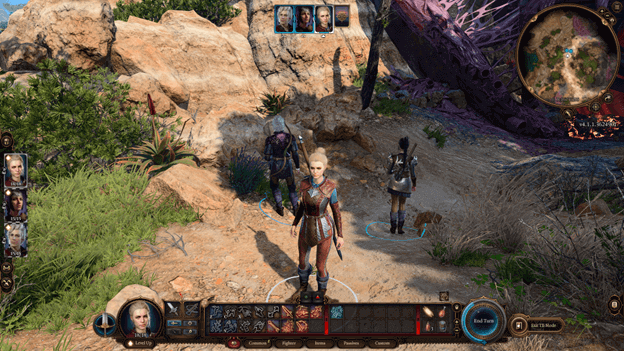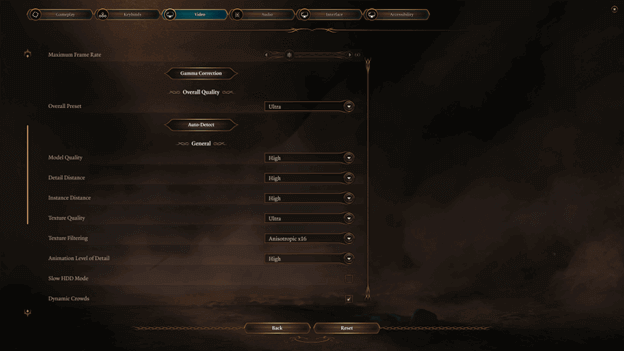Baldur’s Gate 3 has had players waiting for quite some time and now that it is out, some have been wondering if their devices are good enough to play the game.
The good thing about Baldur’s Gate 3 is that even some of the devices with lower specifications can allow players to allow decent graphics, especially when set up properly.
High-end computers can play the game at Ultra Settings but sometimes a little mixing now and then can make the game easier on the eyes.

List of Adjustable Graphic Settings
Display Options
- Display Adapter – Lets you choose which graphics card the game uses.
- Display Monitor – Allows you to select which monitor the game is displayed on.
- Aspect Ratio – Adjusts the height and width of your game screen.
- Resolution – Changes the screen resolutions, offering more performance for lower resolutions.
- Refresh Rate – Sets the number of times per second that an image on your monitor refreshes.
- Display Mode – Allows you to choose between Windowed, Fullscreen, and Borderless Window modes.
- VSync – Adjust the frame rate with your monitor refresh rate to reduce screen tearing.
- Framerate Cap – Limits the maximum frames per second.
- Maximum Frame Rate – Adjusts the maximum number of frames displayed per second in the game.
- Gamma Correction – Adjusts the brightness of game visuals.
Overall Quality
- Overall Preset – Changes the graphics settings based on preset options starting from low quality to ultra.
- Auto-Detect – This allows the game to scan your system and choose which settings would be the best for the game to run smoothly.
General
- Model Quality – Sets the amount of detail used for geometry, allowing higher values to improve the quality.
- Detail Distance – Sets the view distance for viewing smaller objects, which has an impact on memory usage and performance.
- Instance Distance – Changes the distance at which small objects will disappear from your view.
- Texture Quality – Adjusts the quality of textures, which renders more details at higher values.
- Texture Filtering – Alters the sharpness of textures seen from shallow viewing angles.
- Animation Level of Detail – Changes the quality of animations, making higher values provide better animation detail.
- Show HDD Mode – Allows the game to utilize more RAM/VRAM to offload disk usage when loading assets.
- Dynamic Crowds – Enables more dynamic interactions when engaging with crowd characters, which impacts performance.
Lighting
- Shadow Quality – Adjusts the quality of shadows, causing higher values to render higher-resolution shadows.
- Cloud Quality – Changes the quality of clouds, having more detail and depth when set to higher values.
- Fog Quality – Alters the quality of volumetric fog, providing higher resolutions with crisper details and better depth when set to higher values.
Post Process
- Nvidia DLSS – Uses AI Super Resolution to provide the highest possible frame rates at maximum graphics settings. (Requires Nvidia RTX GPU)
- AMD FSR 1.0 – Uses cutting-edge super-optimized spatial upscaling technology to produce impressive image quality at fast frame rates.
- FidelityFX Sharpening – Increases the sharpness of images and restores their details.
- Sharpness – Adjusts how details are precisely rendered in the game.
- Anti-Aliasing – Changes the smoothness of the edges of objects in the game.
- Ambient Occlusion – Allows soft shadows to be created for ambient light.
- Depth of Field – Blurs objects in a scene that is not within the camera’s focus.
- Depth of Field Quality – Changes the resolution and denoising of the depth of field effect.
- God Rays – Creates rays from the sun to illuminate fog and suspended particles.
- Bloom – Simulates a camera sensor that causes very bright parts of images to glow.
- Subsurface Scattering – Creates a more realistic look by simulating light scattering underneath the surfaces of objects.
Best Settings To Choose
Depending on what type of specifications you have, you will be able to enjoy Baldur’s Gate 3 with different settings after optimizing them.
High-End Specs
For systems with high-end specs, you can start with an auto-detect or set things on ultra and adjust things afterward to improve the graphics.
Some of the graphics that you may want to alter after setting your settings to ultra would be:
- Nvidia DLSS/AMD FSR 1.0 – Turn on
- Sharpness – Increase
- Anti-Aliasing – Set to DLAA (Nvidia)
This will improve the graphics to look a bit nicer than normal and running things smoothly should not be much of a problem.
Medium Build Specs
Systems that can run most games but need to take caution when it comes to higher settings don’t need to worry much about playing Baldur’s Gate as performance is often guaranteed at higher settings.
To be on the safe side, it is best to set your graphics to High for this (medium if your fps is below 60) to have good visuals and performance.
You may want to consider changing the following settings:
- Model Quality – Ultra
- Texture Quality – High
- Animation Level of Detail – High
- Shadow Quality – Medium
- Depth of Field – Circular
- Depth of Field Quality – Quarter
Low-End Systems

If you are running a low-end system or are trying to get the game to run on a potato pc, this is still doable with the right settings after changing the overall quality to low.
Even if you are running on low settings, you can still get slightly better visuals with a balance of performance along with it.
After setting your overall settings to low, you may want to alter the following:
- Model Quality – High
- Texture Quality – Medium
- Texture Filtering – Anisotropic x2
- Anti-Aliasing – SMAA
Baldur’s Gate Graphics Issues
If you are having issues with Baldur’s Gate, it is best to make sure that your system meets the minimum system requirements to run the game.
Be sure to update your graphics cards or even do a Windows Update to make sure your system is up to pace with what is needed.
Should the game be experiencing issues such as screen tearing, it would be best to enable Vsync to match the framerates to your monitor.
Verdict
While most systems should be able to run the game smoothly, altering most of the settings can end up with performance being pushed further.
Keep in mind that you are traveling in an open world most of the time, which makes performance better if not much is rendered from a distance.
One of the best ways to mix your settings to find the right graphics would be to start with auto-detect and make changes along the way.